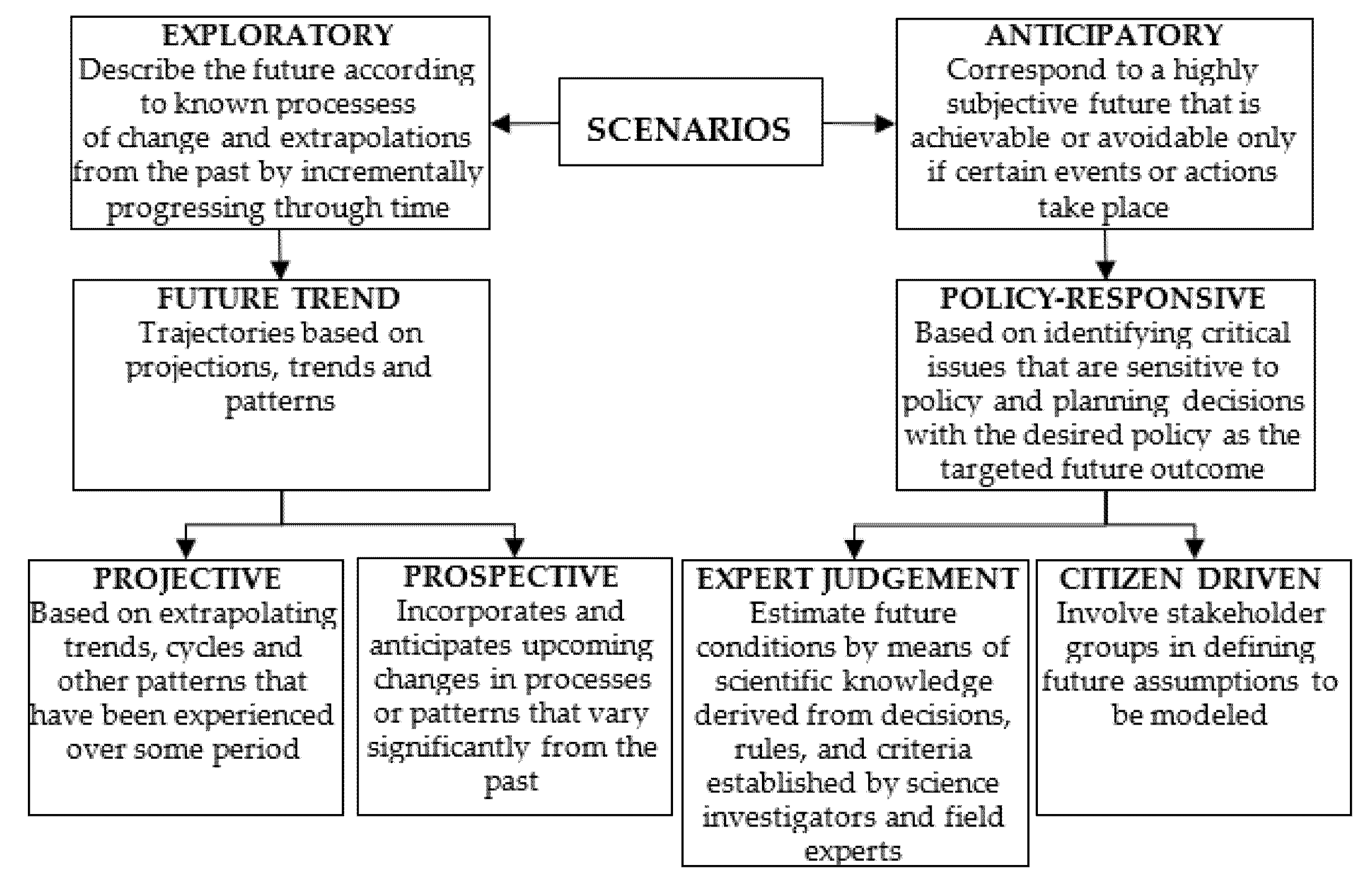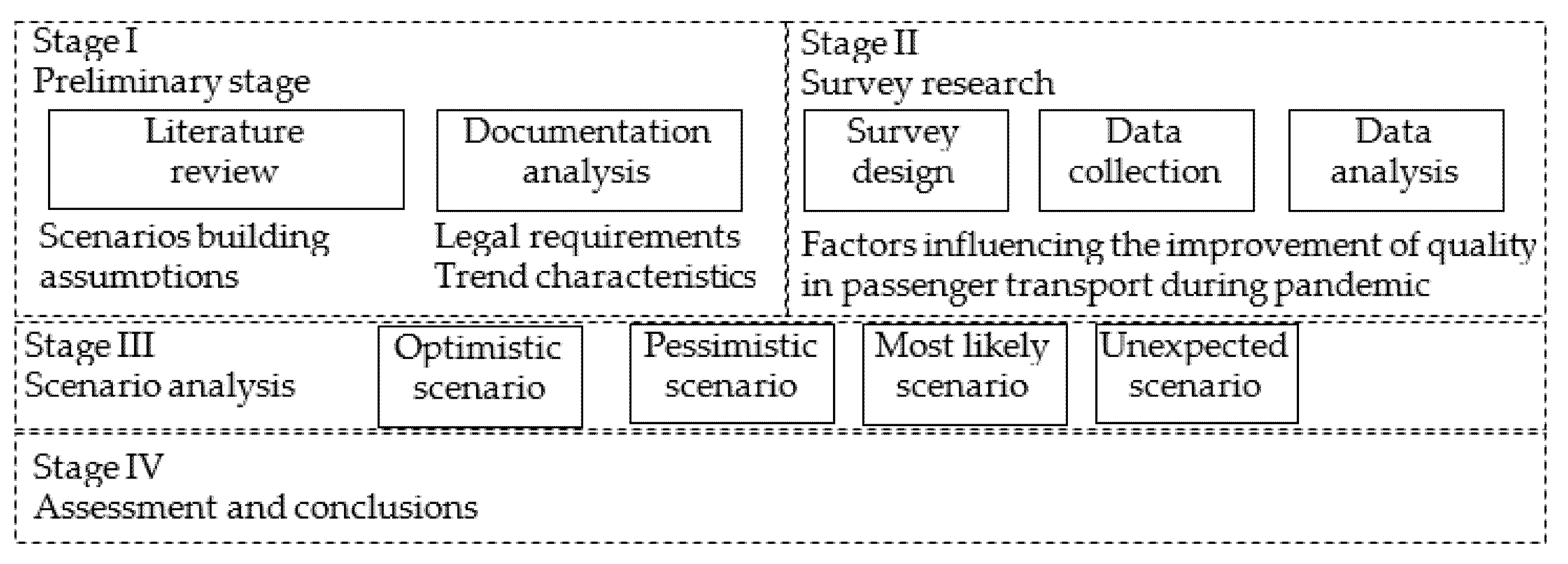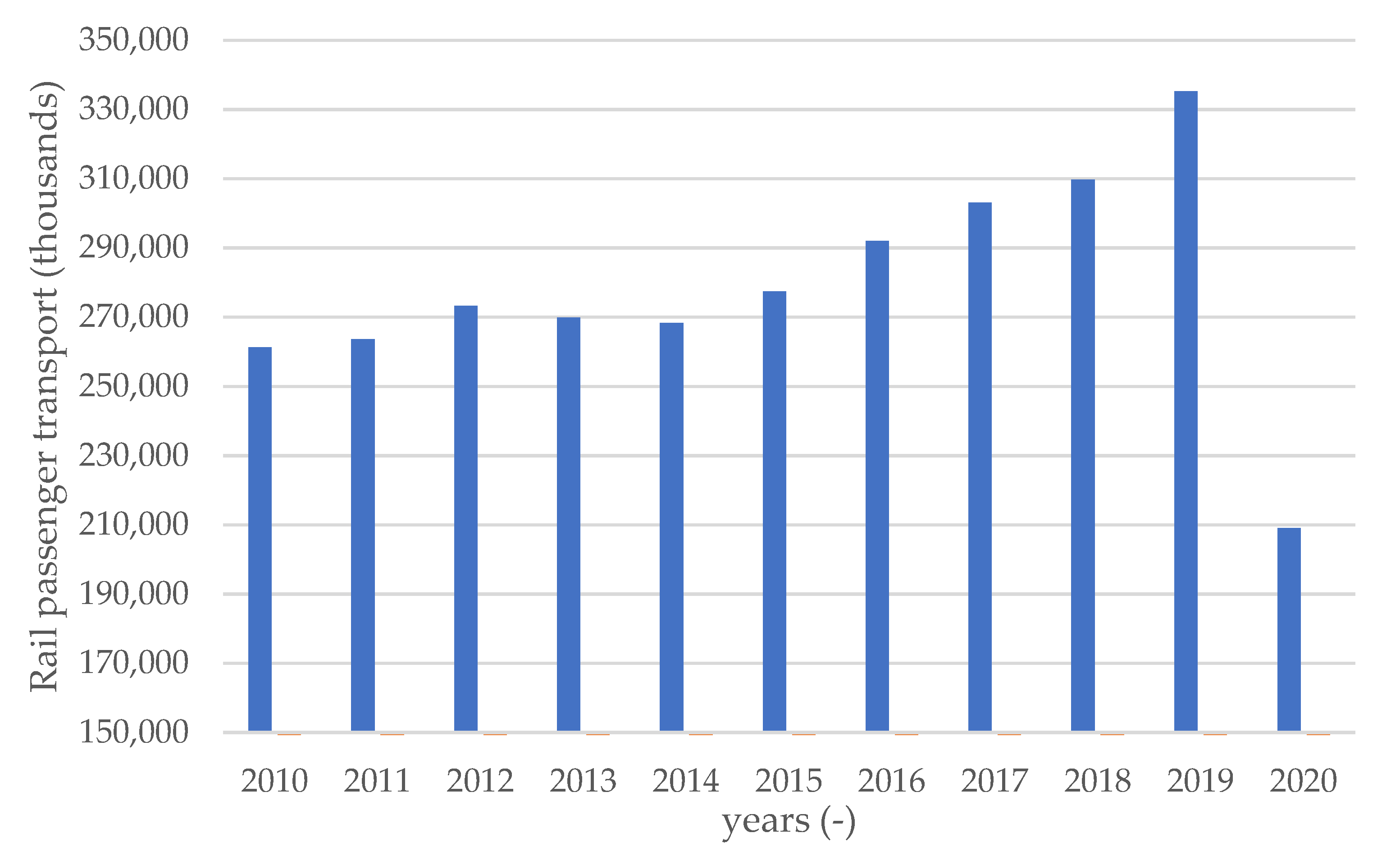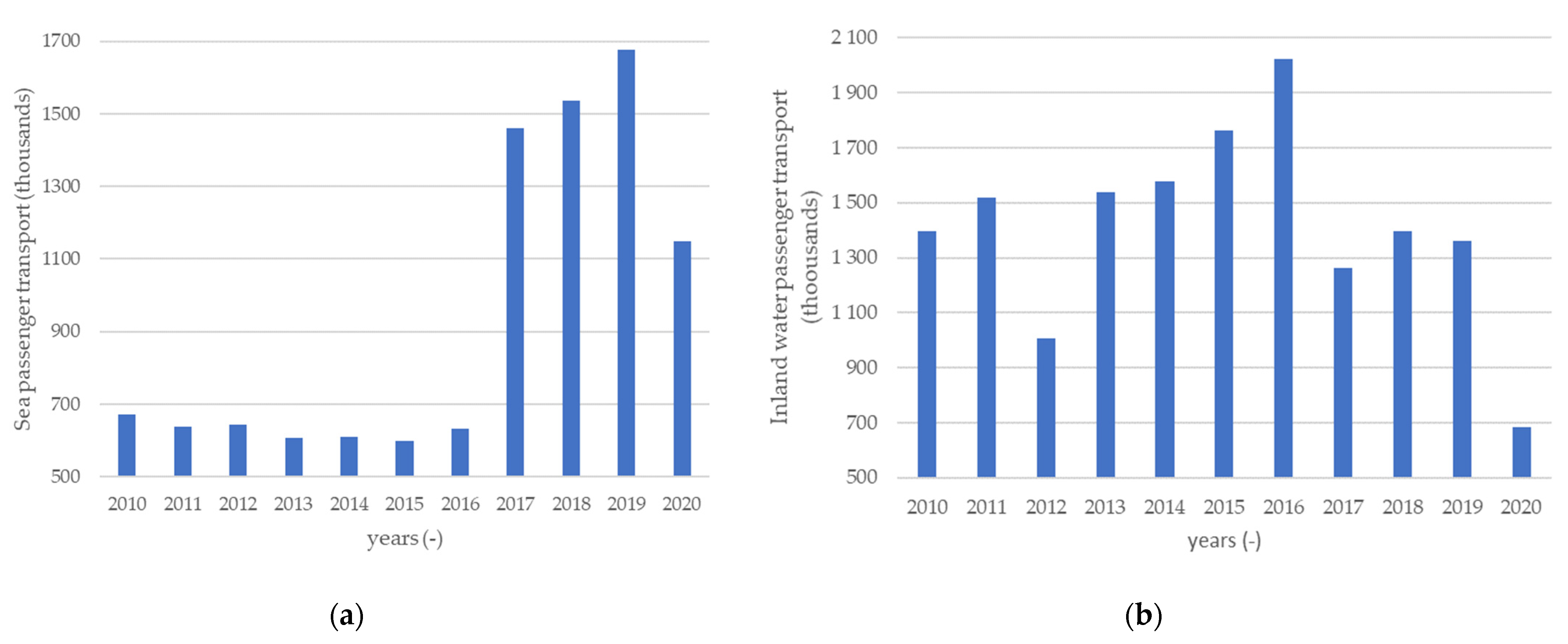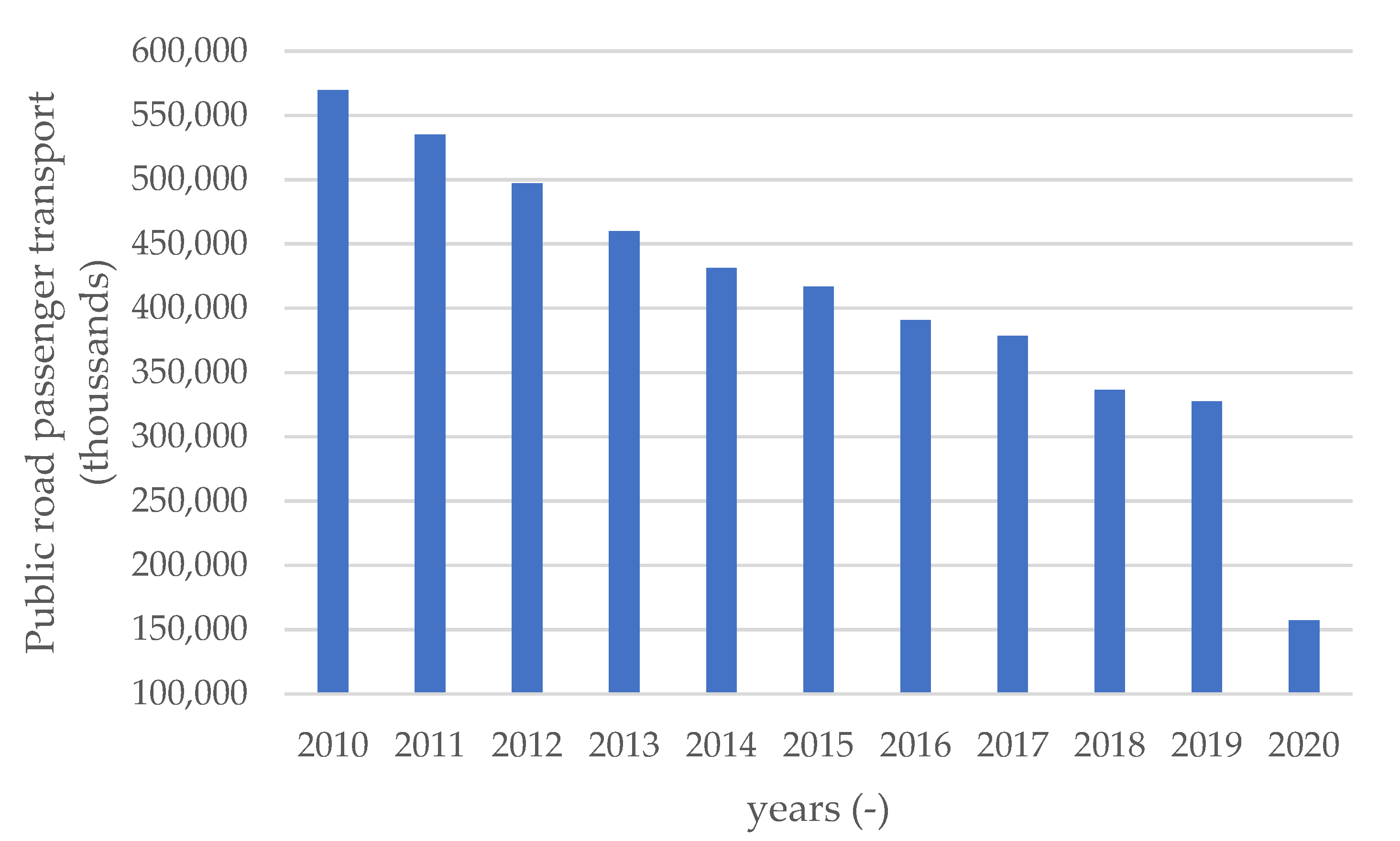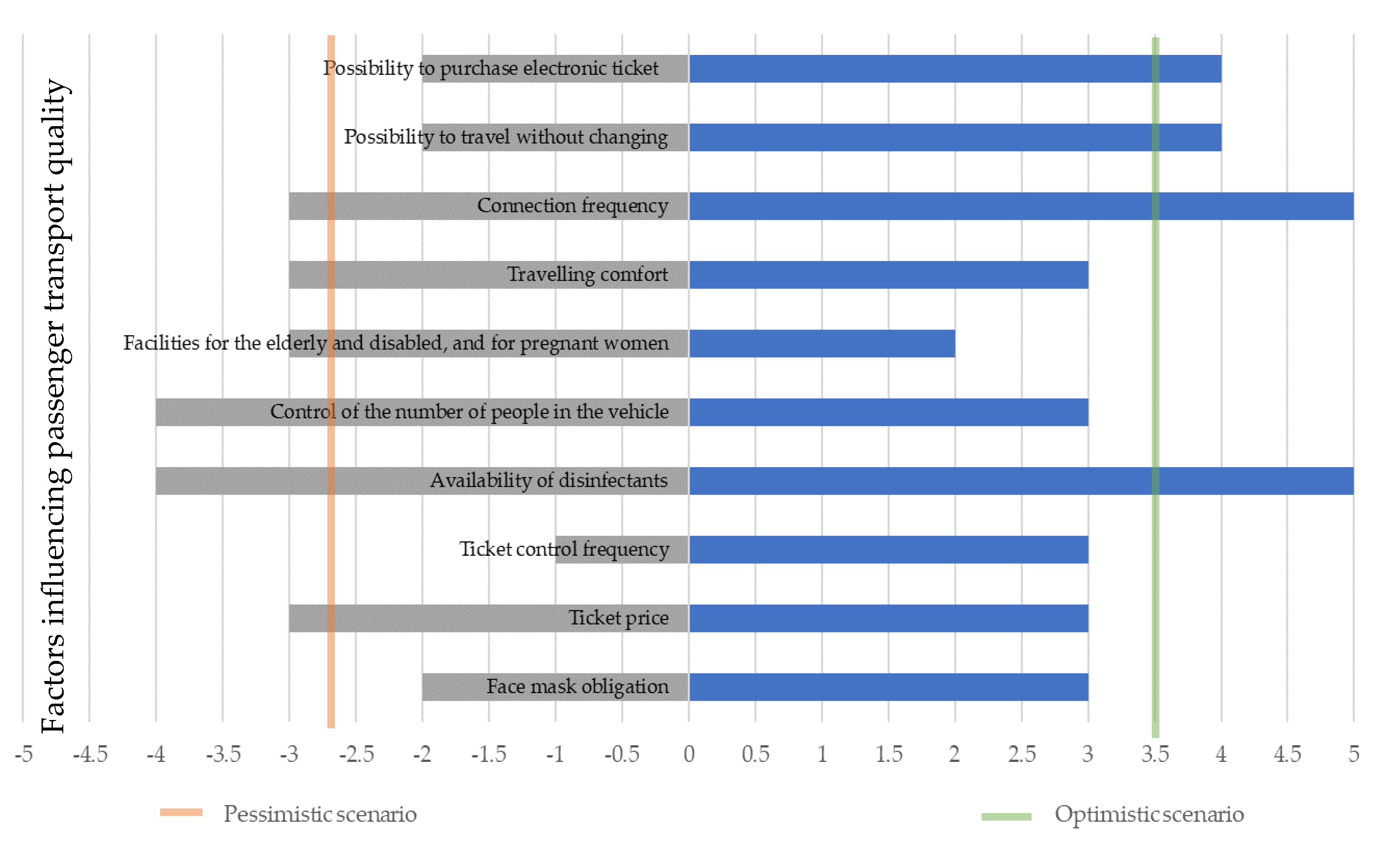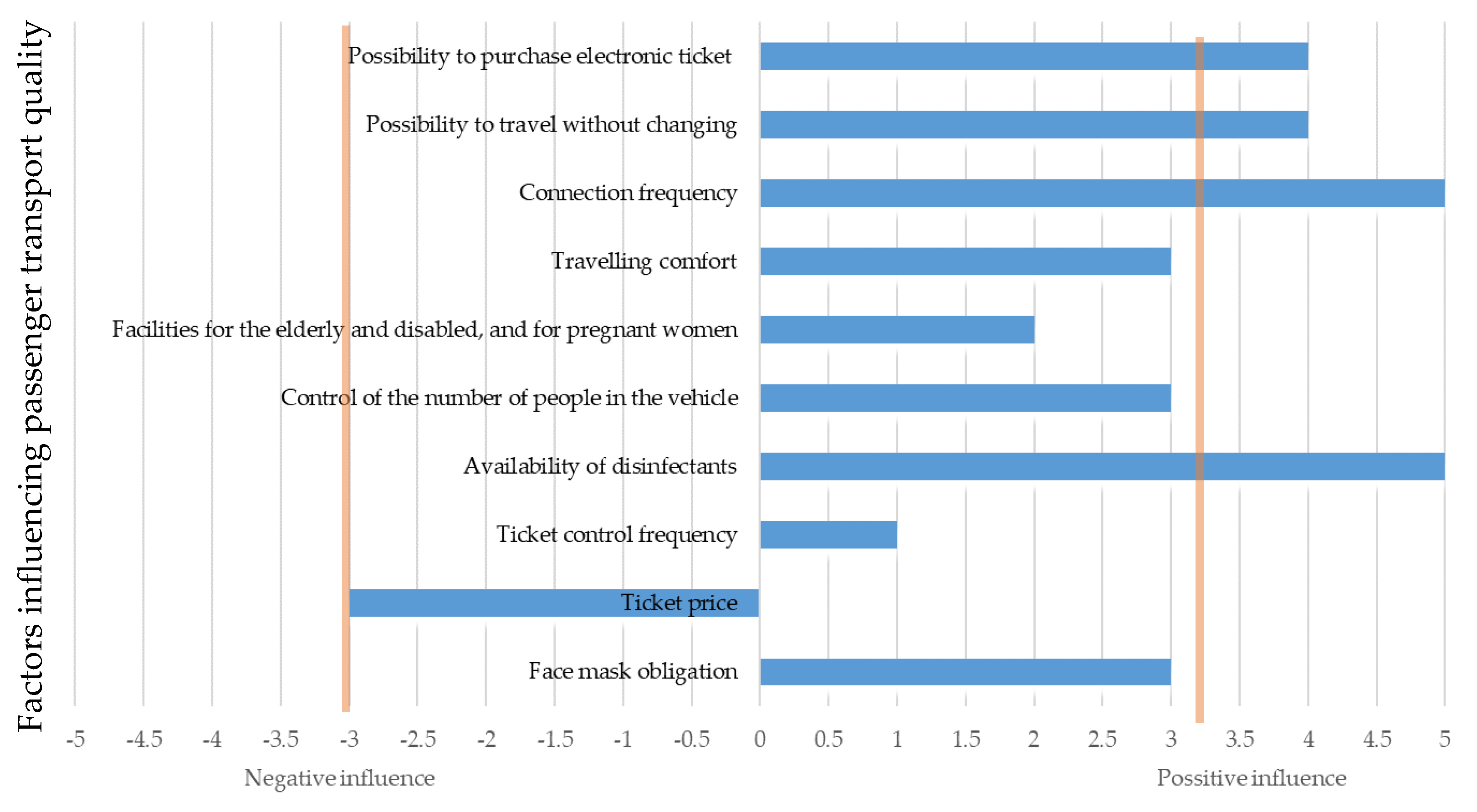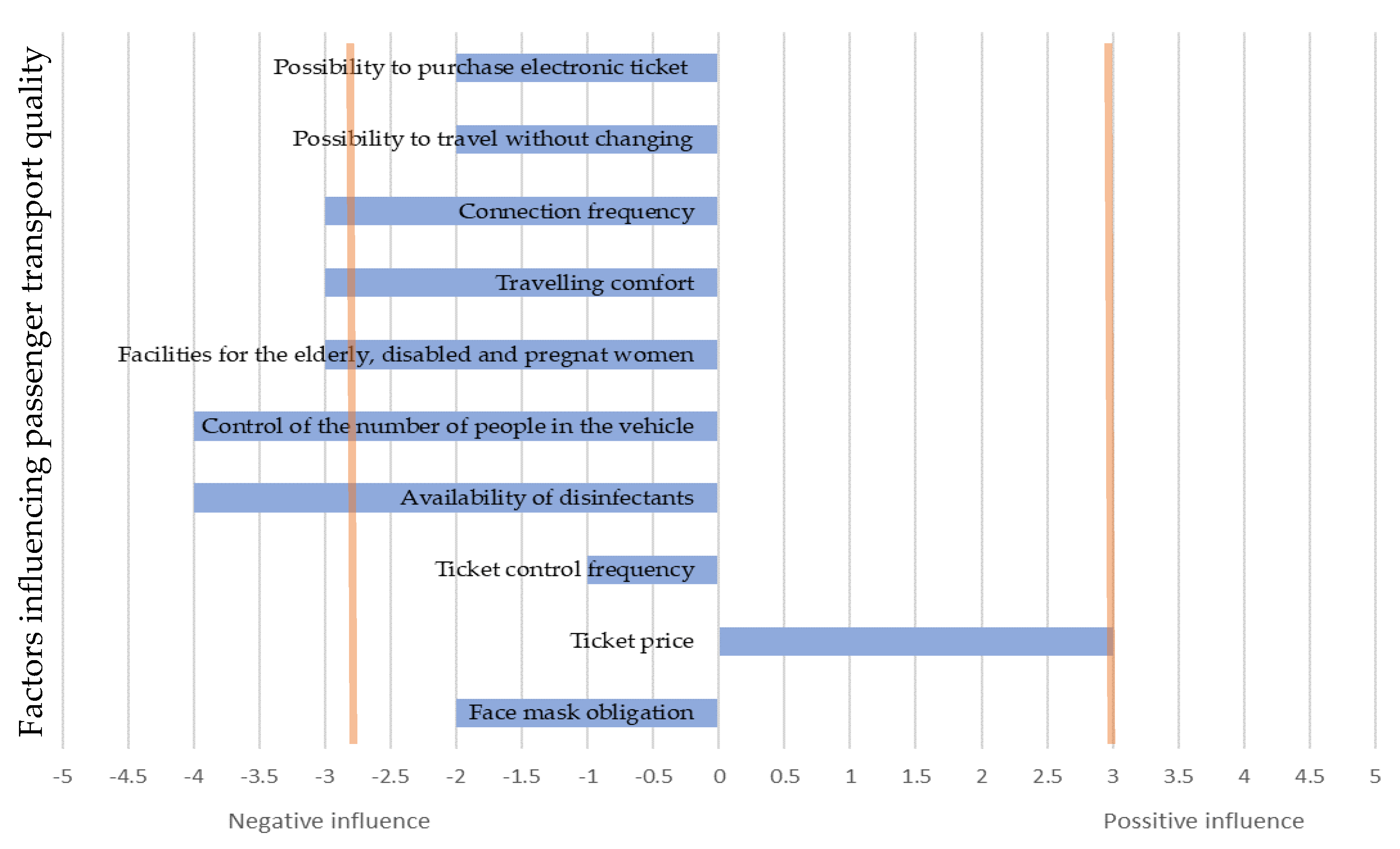1. Introduction
The SARS-CoV-2 coronavirus pandemic has significantly affected the demand for passenger transport services in most countries [
1,
2,
3], including Poland [
4]. This phenomenon is noticeable in all types of passenger transport, such as rail [
5], bus [
6,
7], air [
8], taxi [
9], and public transport [
10]. One of the reasons for this is that the work of schools and universities was suspended, and school pupils and university students constitute a large group of passengers. Many companies also decided to work remotely, which resulted in the reduction of employees commuting to offices. Passengers began to stop using public transport services, which resulted in lower transport performance. Less interest resulted in a change of travel habits [
11,
12,
13,
14] and the increase in popularity of non-motorized activities [
15]. The following trend was noticeable not only for short trips but it also changed the world of tourist transport [
15,
16,
17,
18,
19].
In addition, the organizers of public transport decided to reduce the frequency of journeys or to suspend them altogether, to limit the number of hours of operation of individual lines and change the type of rolling stock used [
20]. The organization of the passenger transport has also changed significantly—the restrictions that were introduced for safety reasons required a complete change in the functioning of public transport. Public transport planning has become a challenge from the perspective of the changes in demand patterns, limited capacity requirements, and other restrictions associated with the COVID-19 pandemic [
21,
22,
23,
24]. These activities include the central opening of doors in vehicles so that passengers do not have to touch buttons and limitation of the maximum number of passengers. The option to buy a ticket from a bus or tram driver has been suspended to reduce social interaction. Vehicles are equipped with personal protective equipment (e.g., disinfectant). Also, the disinfection of vehicles and their more frequent washing is required and drivers’ cabins have been separated to create a safety zone. In rail transport, the possibility of paying by credit card for a ticket has been launched to avoid cash payments. In air transport, pre-boarding obligatory COVID-19 testing is required and after landing in some countries, passengers are sent to quarantine, or either test performance or proof of vaccination is presented.
On board planes and other means of transport and at the airport or stations, passengers must keep their nose and mouth covered. Where possible, passengers should maintain the appropriate distance (1.5 m), which is also means that the airports should offer more buses to transport people to planes.
The issues of passenger transport during the pandemic raised in this article are relevant and important for several reasons. Firstly, they concern the significant problem of threats and risks experienced by transport users, which may consequently contribute to the following changes:
changes in transport habits,
transport modal-split,
development of individual transport means,
changes in urban mobility planning.
Secondly, basing on the citizens’ experiences during the pandemic and the need to provide passenger transport services during the lockdown caused by COVID-19, it is worth indicating the most important macroeconomic trends affecting those services.
Thirdly, the conducted research concerns the design of scenarios of passenger transport development. The obtained knowledge about possible scenarios that may occur in the future in the case of a pessimistic situation of the fourth, fifth, and subsequent waves of COVID-19 cases, and an optimistic one, assuming recovery from the pandemic and a gradual return to the provision of passenger transport services under new changed conditions, is very important. Because of this unstable situation, it is a challenge to determine the demand for transport means.
The scientific purpose of this article was to build various scenarios for the development of passenger transport, considering changes in the demand for these services and factors related to their perception by users of the means of transport. This study investigates transport service future development issues from multiple perspectives, including demand analysis, selection of main factors influencing the development of passenger transport for individual Polish passengers using an online questionnaire, and scenario designs. The main factors influencing the future development of passenger transport and possible scenarios can support public transport service providers in planning their services in the post-shutdown phase as well as in their respective modelling development requirements.
The research area, where investigations of passenger transport services demand were undertaken is Poland. The analysis of passenger travel behavior during the pandemic was conducted mainly in the area of Upper Silesia, Poland, where a cluster of cities called the Upper Silesian-Zaglebie Metropolis (in short the Silesian Metropolis) is located.
The paper is organized as follows:
Section 2 includes a review of the literature on the issues raised in the article. The problem is discussed with emphasis on changes in the transport behavior of the population which occurred immediately after the announcement of the government measures to prevent the spread of COVID-19 and the consequences for the passenger transport services industry. It also presents the scenario method as an analysis tool that helps to describe a possible set of future conditions for development.
Section 3 indicates the methods applied and describes the research approach. It also presents a diagram illustrating the course of research divided into four individual stages.
Section 4 includes an essential part of the article related to building the scenarios for the development of passenger transport in pandemic conditions. These scenarios were based on an analysis of the demand for passenger transport services in Poland during the pandemic and a list of factors influencing the improvement of quality in passenger transport received from the survey results.
Section 5 is devoted to the discussion of the research results with future research directions highlighted. Finally,
Section 6 is devoted to the conclusions.
The overall objective of the paper is to present the possibilities of using the developed scenarios to rationalize decisions in the field of passenger transport service planning in the changing external conditions caused by a pandemic. Assumptions developed for the scenarios of a pessimistic and optimistic situation will enable the preparation of awareness and education programs for passengers and support policies and procedures for transport companies, enabling the further development of their services.
2. Literature Review
Many authors deal with the global outbreak and spread of COVID-19 and its significant impact on the environment of urban areas [
25]. The results of [
26] show that, in terms of thematic focus, early research on the impacts of COVID-19 on cities was mainly related to four major themes: environmental quality, socio-economic impacts, management and governance, and transportation and urban design. Research on future consequences of the pandemic usually focuses on the consumption of urban transportation fuel and the corresponding CO
2 emissions [
27] and other air pollutants [
28,
29].
Analysis of changing fuel consumptions, traffic volumes, emission levels, and an understanding of human travel behavior can help the government assess the impact and plan the corresponding strategy for such a pandemic in the future. The decision process however is very tough and sometimes time-consuming. The time-lag effect reflected in transportation systems when authorities take action in response to the COVID-19 pandemic has also been quantified [
30].
Modeling, forecasting, and controlling infectious diseases through scenario-building based on predictions is well known [
31,
32,
33]. The behavior of the COVID-19 epidemic was simulated on different contact networks showing seesaw scenarios of lockdown in [
34]. In addition, predictions of coronavirus pandemic exit are very important as they influence sustainable development and have health, economic, and public policy implications [
35,
36]. The extended time of precision seems justified here because as noted in [
37] global crises caused by the pandemic of COVID-19, since early 2020, can even compromise the world’s commitment to the 2030 Agenda for Sustainable Development.
Scenarios seem to be appropriate methods for analyzing discontinuous changes. Non-continuous change is understood as a direct jump between the past and the present as well as between the present and the future. In this method, therefore, there is no tedious observation of changes in individual factors. It allows for the determination of multi-variants that it will be possible to achieve in future states of the environment.
Scenarios belong to the research tools of phenomena in which relationships between particular events can be observed and different points of view can be drawn. They are an ideal solution for building long-term forecasts, in which there is not enough data related directly to the examined object. Authors in [
38] define scenarios, then classify them along three axes—exploratory–mixed–anticipatory, descriptive–dynamic–normative, and trend–compound–peripheral. This comprehensive three-dimensional classification is represented by a cubic diagram, showing 27 different types of scenarios. Some of them are shown in
Figure 1 [
39].
Scenarios of environmental states stand out from other methods because of their emphasis on qualitative characteristics [
40]. They examine the impact forces of selected processes occurring in the environment and the probability of their occurrence. Due to the qualitative approach, the estimation of the strength of individual factors is made only by the forecast. It must be possible to correctly characterize processes that is difficult to measure or are completely immeasurable, although mathematical or heuristic methods may also be used. When applying the rules of conducting this method, the forecaster should be able to set additional scenarios such as optimistic, pessimistic, surprising, and most likely.
Scenario-forecasting methods were used world-wide according to aspects of the COVID-19 pandemic. Part of the research was focused on the assessment of scenarios of social distancing mandates and levels of mask-use for the USA [
41], Jordan [
42], Germany [
43], France [
44], Moscow (Russia) [
45], Egypt [
46], Brazil [
47], and other countries.
In [
48] seven scenarios were focused on economic issues and demonstrated the scale of costs that might be avoided by greater investment in public health systems in all economies but particularly in less-developed economies where health-care systems are less developed and population density is high. Another issue of forecasting is the climate, and the impact of COVID-related lockdowns on environmental and climate change scenarios was developed in [
49]. Also, public acceptance of lockdown was provided in [
50] and the political impact of the pandemic in [
51].
Many tools and methods were used by researchers in these scenarios, including predictions based on the Bayesian model [
52,
53], SIR models [
54,
55], an agent-based model and a deterministic compartmental model [
56], fractional models [
57], and a modified SEIR compartmental model [
58].
Scenario planning is a good method for pandemic strategic analysis and planning by organizations across multiple sectors and geographic regions, but as proved in [
59] quickly-produced scenarios are not embedded in the realities of affected communities. That is why the scenario-development process should be enhanced to either involve power-holding stakeholders or, more straightforwardly, to activate local consideration of how the affected community might/might not wish to react to localized dilemmas connected with the pandemic situation.
3. Materials and Methods
The research was conducted in four stages covering theoretical and practical analysis. The research hypothesis was based on the statement that it is possible to support decisions based on scenario methods in the field of passenger transport development and its quality.
Stage I was the preliminary stage focused on the literature and documents (legal acts, regulation of the Minister of Health and Epidemiological Services, regulations of passenger transport organizers regarding the application of restrictions in the means of transport, and statistics on the volume of passenger transport). As a result, the assumptions and objectives of future scenario-building were developed. Also, the legal requirements and trend characteristics of passenger transport during the pandemic were defined.
Stage II was focused on the survey research. First, the questionnaire was defined. Then, the link to the survey was sent electronically and data were collected. Finally, the data were analyzed to enable the selection of the main important factors influencing the improvement of quality in passenger transport during a pandemic.
Stage III of the research was concentrated on scenario-building. The scenarios were based on the analysis from the previous stages. Four scenarios of future passenger transport development were built: optimistic, pessimistic, most likely, and surprising (unexpected).
Finally, stage IV covered the assessment of the scenarios and conclusions on future passenger transport development.
The diagram showing the implementation of the theoretical and analytical research stages is illustrated in
Figure 2.
In the literature review section, the results and achievements of scientists were taken into account. Restrictive conditions regarding the provision of passenger transport services during the COVID-19 pandemic and statistical data on demand for them were prepared based on a Polish case study. The survey studies, due to the increased risk of SARS-CoV-2 infection, were conducted in a non-contact manner, using an online questionnaire among students and workers from the Faculty of Transport and Aviation Engineering at the Silesian University of Technology.
4. Scenarios for the Development of Passenger Transport in Pandemic Conditions
The scenarios for the development of passenger transport in pandemic conditions were built based on trends regarding passenger transport in Poland and factors influencing the improvement of quality in passenger transport during a pandemic. Development trends of individual factors were compiled based on analysis of the demand for passenger transport services during the pandemic in Poland. The factors were developed from the survey that enabled scenario planning and that assigned factors that had a key impact on the quality of public transport services during the COVID-19 pandemic.
4.1. Passenger Transport in Poland during the COVID-19 Pandemic
The demand for passenger transport is related to the needs of consumers and their purchasing power. The volume of supply of services related to the movement of people is influenced, inter alia, by investment issues, the length and geographic distribution of the communication network, or by permanent operators. The COVID-19 pandemic has had an impact on the market in recent years in every country, including Poland, influencing the demand and supply.
The Polish rail transport sector recorded a decrease in the number of passengers in domestic transport of approximately 80% [
60]. The volume of passenger transport by rail was negatively affected by restrictions related to the number of passengers and the possibility of illness among the staff [
61]. In 2010, the number of passengers transported in rail transport was 261,314 and each year there was an increase in people using transport services, which can be seen in
Figure 3 [
62].
In 2015, the number of passengers handled was 277,321, while in 2019 it was 335,264. Compared to the data from 2019, in 2020 domestic and international transport decreased significantly. The transport services were carried out with caution, while the trains ran to a limited extent. The first quarter of 2020 showed a reduction in public transport, which resulted in a decrease in the volume of rail transport. The number of passengers using rail transport during the peak season was around 16%, and 9% off-peak. On weekends, the maximum amount was 8%. As a result, the number of running trains was drastically limited.
The aviation passenger market was becoming more and more popular every year, strengthening its transport position. Because of the outbreak of the pandemic, most countries have introduced numerous restrictions, and in periods when the number of infections has increased, regular passenger flights are most often suspended, which has had a negative impact on air transport. The traffic ban had an impact mainly on the results of the first two quarters of 2020. Despite the resumption of passenger traffic, the advent of another wave of the virus reduced interest in aviation in the last quarter of the year. The number of international passengers was 70.7% less than in the previous year, while the number of domestic passengers decreased by 2.6 million, or 65.4%. Regular services showed a decrease in the number of passengers by 30.5 million, i.e., 69.5%, while charter service, passenger numbers reduced by 77.3%, i.e., by almost 4 million. Warsaw Chopin Airport, which is the largest in Poland, handled almost 13.4 million passengers less than in 2019. In 2020, Polish airports handled 70% fewer passengers than in the previous year. It is worth noting that the last time when fewer passengers were handled was 15 years ago [
63].
The transport of passengers by sea is much smaller compared to road or air transport. Nevertheless, in 2017, a significant increase in interest in sea travel was observed, as the number of passengers handled in seaports more than doubled. In the preceding years, the number of travellers had a downward trend and amounted to approximately 650,000, which is shown in
Figure 4a.
In the following years, the number of passengers increased. In 2019, 9.3% more passengers were transported than in 2018. In 2020, there was a decrease in the number of passengers served at ports by around 530,000 due to the pandemic. The demand for passenger services by inland transport is highly volatile.
Figure 4b shows the spikes of interest in this type of transport among travellers.
As can be seen, in 2011 there was an increase in the number of passengers handled compared to 2010, but in 2012 there was a significant decrease by about 500,000 people. From 2013 to 2016, the number of travellers by inland transport increased. In 2017, there was another decrease of approximately 36%. In 2018, the number of passengers transported amounted to 1,395,300. and it was 2.4% more than in the following year when there were 1,361,600 passengers. 2019 was the year of the COVID-19 outbreak, when restrictions on the crew and entry options to other countries were introduced. The lowest figure was in 2020 when the number of passengers was less than 700,000.
Public road transport, which was the most popular that year also recorded a decline in interest among the passengers. Most likely, this is caused by investments in people’s own means of transport, as the number of registered cars in Poland increased during this period. From 2010 to 2019, there had been a regular decline in road transport, which can be seen in
Figure 5.
In 2020, the number of passengers transported by public road transport decreased threefold compared to 2019. In the era of the pandemic, numerous restrictions were introduced in the form of fewer places in vehicles, access to disinfectants, or the inability to buy tickets from the driver. Public fears and messages about staying at home caused the interest in public transport to decrease significantly, and the carriers themselves stopped inter-city services.
Due to the introduction of remote work in many enterprises, the demand for public transport services used by commuters is decreasing. In 2020, a significant decrease in the number of passengers using public means of transport could be observed, as children and adolescents constituted a large group of travellers, and the introduction of remote learning significantly reduced their needs related to traveling. In 2021, there was an upward trend in the number of passengers in public transport compared to the previous year. The situation started to improve as more routes were introduced, which resulted in an increase in the space per passenger. At the beginning of the COVID-19 pandemic, the use of public transport raised some concerns for passengers about the possibility of contracting the SARS-CoV-2 virus. After a year, the situation partially changed as travellers became aware of the use of personal protective equipment and the safe use of public transport.
4.2. Factors Influencing the Development of Passenger Transport Based on the Survey
Factors influencing the development of passenger transport were taken from the survey results. The survey was conducted in electronic form, and a request to complete it was sent to all students of the fifth semester of transport studies at the Faculty of Transport and Aviation Engineering of the Silesian University of Technology and to employees of this faculty.
A total of 150 people of different ages answered the questionnaire. Women accounted for slightly more than half of the respondents. About 65% of people taking part in the survey are city inhabitants. Through the survey results, it was possible to determine factors that had a key impact on the quality of public transport services during the COVID-19 pandemic (
Table 1). The respondents underlined several factors that are most important in passenger transportation during the pandemic and that influence the quality of services, regardless of whether it was taxi, bus, tram, train, or air transport:
obligation to wear masks in passenger means of transport;
price of the tickets;
frequency of ticket control;
availability of disinfectants in means of transport;
control of the number of people in the vehicle;
facilities in vehicles for the elderly or disabled, and for pregnant women;
travelling comfort;
connection frequency;
possibility to travel without changing vehicles;
possibility of electronic ticket purchase in public transport.
Some of these factors were more universal and some became burdensome for the respondents during the pandemic. There were also new ones that were especially distinguished as influencing the quality of passenger transport services and that were not taken into account before the pandemic.
Based on the survey results, it was possible to determine the strength of the influence of each of the specified factors as indicated by the respondents in the survey results and this is presented in a scale from −5 to 5. The probability of each of the factors occurring in
Table 1 was based on the analysis of the current situation related to the demand for passenger transport services and was performed in a scale from 0 to 1.
4.3. Scenarios of Future Passenger Transport Development
Scenario planning methodology was based on the following stages performed in [
64]:
Selection of the most important factors influencing the quality of transport services (see point 4.2);
Specification of individual processes occurring in the macroenvironment, including:
Determination of the strength and direction of the impact on the tested object on a scale from −5 to +5;
Analysis of three variants of changes (growth trend, recession trend, or stabilization).
Selection of appropriate forecasting trends in the form of:
Optimistic scenario, based on the most favorable trend for a given object;
Pessimistic scenario, which may have the most negative impact on the research object;
Most likely scenario, which is the most rational premise as to the condition of the object in the forecasted model;
Unexpected scenario, which, according to the received trends, has the smallest probability of occurrence.
Graphical representation of the results in the form of a scenario layout.
This methodology was used to build the scenarios of future passenger transport development. The initial stage in creating the scenarios was therefore to determine the strength of the impact of each of the specified factors and the probability of each of them occurring. Four scenarios were then generated: optimistic, pessimistic, most likely, and unexpected.
Based on the analysis of factors, it was possible to create an optimistic scenario in which the greatest strength of the impact was considered to be the availability of disinfectants and the increase in the frequency of connections. The average strength of the influence of all factors in the optimistic scenario was +3.50.
Another scenario was the pessimistic scenario, in which the average strength of the influence was −2.70. The given forces characterized the negative impact of the given factors on the quality of passenger services, as all values were less than 0.
Figure 6 shows a graphical interpretation of the optimistic and pessimistic scenarios. Factors that go beyond the average impact strength of +3.5 are the possibility of electronic ticket purchase in public transport, the possibility to travel without changing, connection frequency, and availability of disinfectants. Taking into account the pessimistic scenario, six factors could be distinguished beyond the average value of the impact strength, which was: −2.70.
The most likely scenario, presented in
Figure 7, shows the strengths of the influence of trends that are most likely to occur. After performing the analysis, it was possible to determine the range that determines the most positive and the most negative impact forces of the selected factors. In this case, only one factor has a negative influence on the development of passenger transport in Poland, and that was the trend of rising ticket prices. The negative influence average was −3.0 and the positive influence average was +3.33.
Unlike the most-likely scenario, the unexpected scenario is based on selecting the strength of the influence of the trends that are least likely to occur. The only trend with a positive force, in this case, was the fall in ticket prices. The negative influence average was −2.67 and the positive influence average was +3.00 are presented in
Figure 8.
Analysing the unexpected and the surprising scenarios, two factors, the number of people and availability of disinfectants, stand out as having an above-average negative impact strength.
5. Discussion
Perhaps the most fundamental finding of this research is that there is a range of different scenarios that, with the optimal combination of various factors can help to understand the essence of maintaining the quality of services in passenger transport during a pandemic.
The analysis of transport users’ opinions showed significant changes in their behavior and thus the elements considered when choosing a specific means of transport and the perception of the quality of services in this area during the lockdown. Regarding the questionnaire results, ten factors influencing passenger transport quality in pandemic were selected. Some of these factors are rather universal considering the perception of service quality, for example price of the tickets or travelling comfort. Some of the factors became more important for the respondents only during the pandemic, for example connection frequency due to the limited number of passengers in vehicles or the possibility of electronic ticket purchase in means of public transport. The factor of availability of disinfectants in means of transport appeared as a new factor influencing the quality of passenger transport services and was not considered before the pandemic.
The research results show that changes in traveling behavior should be well understood and used appropriately by city authorities and transport operators. The main activities should be aimed at making the public transport sector more attractive due to the fact that studies have shown greater use of individual transport during a pandemic [
65,
66]. Results in [
67] indicate that public transport lost ground during the particularly restricted period of lockdown while individual modes of transport, especially the private car, became more important. The deepening phobia of sharing means of transport may lead to an increase in the unfavorable phenomenon of congestion in cities.
It must be underlined that the survey was only conducted in a small group. Extending the research to other social groups or people in other professions could change the results. The largest group among the respondents in the research conducted were students, who were learning and working, and aged 18–26. People of this age have different priorities in terms of the quality of transport services than older people. This problem deepened even more during the COVID-19 pandemic, which was a much greater threat to the elderly. For people who use public transport frequently, the key issue in choosing factors was the frequency of travel. For them, the impact of this factor on the quality of travel was more important than for people who use public transport rarely. Another aspect that determined the choice of factors was the place of residence, as people living in the countryside have limited access to some means of public transport. Residents of large cities can decide on the choice of means of transport due to their availability. The diversity of the survey results was mainly related to the age range of the respondents and their place of residence, as belonging to each of these groups generates different needs regarding the quality of transport services.
The results of the survey made it possible to determine the strength of the influence of a given factor on the development of public transport. In turn, the probability of the trend behavior was estimated after analyzing changes in demand for these services on the Polish market compared to previous years. The analysis of the demand for passenger transport services was based on statistical data. It was shown that, compared to 2019, a decrease in passenger transport took place in all sectors. To sum up, the decrease in sea passenger transport was 68.46%; in rail passenger transport, 62.36%; in inland water passenger transport, 50.07%; in public road transport, 48.03%; and in air passenger transport, 16.58% compared to the year before the COVID-19 pandemic.
The results of the analysis of the statistical data and of the survey made it possible to analyze the factors influencing the quality of transport services. On this basis, four environmental scenarios with graphical interpretation were created—pessimistic, optimistic, most likely, and surprising (unexpected).
In the optimistic scenario, the most positive impacts taken into account as the key factors were the frequency of travel of the means of transport and the time-specific factor of the pandemic—the availability of disinfectants. This means that the provision of disinfectants and their widespread use among travelers may become a permanent element of improving the quality of passenger transport services. Interestingly, this factor was equally important in the case of a pessimistic scenario, including the next wave of the pandemic. Due to the spread of this factor in the optimistic and pessimistic scenarios, its high turbulence can be assumed, but it must certainly be taken into account by stakeholders. This also means that the solutions they will impose will have a huge impact on the rhythm of progress in the development of passenger transport in Poland.
Another equally important factor was the need to control the number of passengers in vehicles, which is mainly related to the difficulties for transport organizers in organizing the greater number of vehicles servicing given transport connections. However, from the users’ point of view, a smaller number of passengers can improve the comfort of travel and thus becomes an important factor influencing its quality. The correct interpretation of this factor in the media and marketing may contribute to gaining a competitive advantage in the services market.
In the developed model, the ticket inspection frequency factor was presented as having the lowest turbulence. This can be interpreted as a noticeable impact of this element on the development of passenger transport, which, however, will not be a critical factor in any of the scenarios.
The most sensitive factor in the surprising and most probable scenarios was the price of the tickets. Due to the costs to be borne by passenger transport operators, considering the greater frequency of vehicles, lower vehicle occupancy, and additional measures preventing the rapid spread of the coronavirus, an increase in prices can be expected. It seems unlikely that they will decrease, which may lead to an increase in the use of individual transport and progressive congestion. For this reason, this factor should be taken into account by decision-makers responsible for including more public transport subsidies in the budget.
Future research directions may include the verification of the obtained scenarios depending on the changing epidemic conditions in Poland. Similarly, research can also be carried out in other countries or other spheres of services to reflect common areas and enable more efficient decision-making.
6. Conclusions
The recent outbreak of COVID-19 has left many officials, authorities, and governments in a difficult position. Decisions have sometimes led to adverse reactions and strong resistance from entrepreneurs and sections of society and have led to changes. One of these changes was the travelling behaviour of urban residents and the perception of the quality of passenger transport services. People of different ages have different priorities in terms of the quality of transport services. The mobility of the elderly is largely different from that of the younger generation due to difficulties in using modern technological solutions. People over 50 have more concerns about traveling by public transport than younger people. Due to the downward trend in the number of passengers traveling by public road transport, it was necessary to conduct an analysis aimed at improving the quality of transport services so that this tendency can be changed into an upward trend in coming years.
The aim of this research has been achieved and four scenarios for the development of passenger transport were created, considering changes in the demand for these services and factors related to their perception by users of means of transport. The conducted analysis made it possible to identify the aspects that have the greatest impact on the scenarios under consideration. Increasing the frequency of connections and the availability of disinfectants are among the factors that have the greatest impact on the quality of transport services in the optimistic scenario. On the other hand, the factors that have a negative impact on the quality of services in public collective transport are the control of the number of passengers and the availability of disinfectants. Failure to respect these aspects may lead to a declining number of passengers using public transport.
The forecast shows that many factors must be taken into account for the development of passenger transport in the difficult time of the pandemic, but also shows how complex the decision-making process is in the turbulent changes of the environment. For this reason, taking into account multi-variant environmental scenarios may become a useful tool for forecasting the development of future events and making current decisions. These findings are highly relevant for transport policy when developing measures for expanding the possibilities for promoting sustainable individual transport and developing public transport. These aspects are key to achieving a sustainable transport system during another wave of COVID-19 and also after it has subsided.
